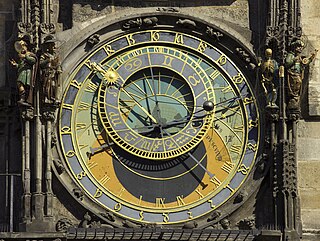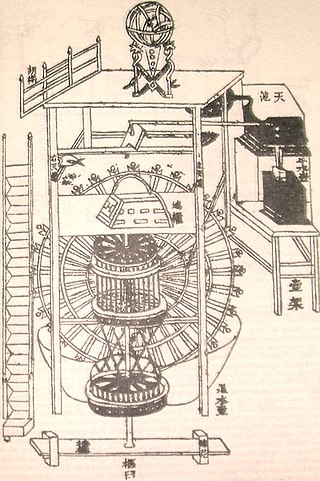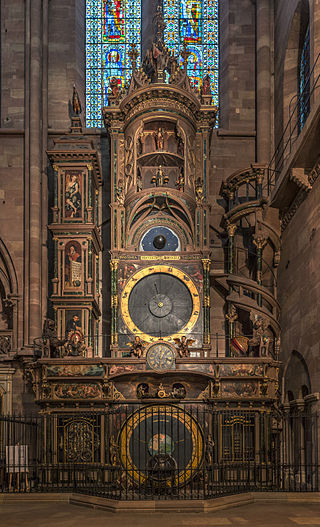
The Leicester University astronomical clock is a modern astronomical clock at the University of Leicester.

The Leicester University astronomical clock is a modern astronomical clock at the University of Leicester.
The clock was installed in 1989 on the side of the Rattray Lecture Theatre at the University of Leicester. It was designed and constructed by Allan Mills and Ralph Jefferson. [1]
The display is 8 feet (2.4 m) in diameter.

Greenwich Mean Time (GMT) is the local mean time at the Royal Observatory in Greenwich, London, counted from midnight. At different times in the past, it has been calculated in different ways, including being calculated from noon; as a consequence, it cannot be used to specify a particular time unless a context is given. The term GMT is also used as one of the names for the time zone UTC+00:00 and, in UK law, is the basis for civil time in the United Kingdom.

The second is the unit of time in the International System of Units (SI), historically defined as 1⁄86400 of a day – this factor derived from the division of the day first into 24 hours, then to 60 minutes and finally to 60 seconds each. "Minute" comes from the Latin pars minuta prima, meaning "first small part", and "second" comes from the pars minuta secunda, "second small part".
Universal Time is a time standard based on Earth's rotation. While originally it was mean solar time at 0° longitude, precise measurements of the Sun are difficult. Therefore, UT1 is computed from a measure of the Earth's angle with respect to the International Celestial Reference Frame (ICRF), called the Earth Rotation Angle. UT1 is the same everywhere on Earth. UT1 is required to follow the relationship

The United States Naval Observatory (USNO) is a scientific and military facility that produces geopositioning, navigation and timekeeping data for the United States Navy and the United States Department of Defense. Established in 1830 as the Depot of Charts and Instruments, it is one of the oldest scientific agencies in the United States, and remains the country's leading authority for astronomical and timing data for all purposes.

The University of Leicester is a public research university based in Leicester, England. The main campus is south of the city centre, adjacent to Victoria Park. The university's predecessor, University College, Leicester, gained university status in 1957.

A water clock or clepsydra is a timepiece by which time is measured by the regulated flow of liquid into or out from a vessel, and where the amount of liquid can then be measured.

Clock towers are a specific type of structure that house a turret clock and have one or more clock faces on the upper exterior walls. Many clock towers are freestanding structures but they can also adjoin or be located on top of another building. Some other buildings also have clock faces on their exterior but these structures serve other main functions.

The Prague astronomical clock or Prague Orloj is a medieval astronomical clock attached to the Old Town Hall in Prague, the capital of the Czech Republic.

An astronomical clock, horologium, or orloj is a clock with special mechanisms and dials to display astronomical information, such as the relative positions of the Sun, Moon, zodiacal constellations, and sometimes major planets.

The Constantinople observatory of Taqi ad-Din, founded in Constantinople by Taqi ad-Din Muhammad ibn Ma'ruf in 1577, was one of the largest astronomical observatories in the pre-modern world. However, it only existed for a few years and was destroyed in 1580.

Su Song, courtesy name Zirong, was a Chinese polymathic scientist and statesman. Excelling in a variety of fields, he was accomplished in mathematics, astronomy, cartography, geography, horology, pharmacology, mineralogy, metallurgy, zoology, botany, mechanical engineering, hydraulic engineering, civil engineering, invention, art, poetry, philosophy, antiquities, and statesmanship during the Song dynasty (960–1279).

The Haymarket Memorial Clock Tower is a major landmark and popular meeting point in Leicester, United Kingdom. It is located roughly in the middle of the area inside the ring-road, and is at the point where five major streets meet; Gallowtree Gate, Humberstone Gate (A47), Haymarket (A607), Church Gate (A6) and Eastgates (A47).

Hyde Memorial Observatory is a community astronomical observatory located in Lincoln, Nebraska (USA) surrounded Holmes lake. It is run totally by volunteers, furnished through public donations, and devoted purely to public viewing. It is named after a donation given by Flora Hyde in honor of her late husband Leicester, and opened in 1977.

The Strasbourg astronomical clock is located in the Cathédrale Notre-Dame of Strasbourg, Alsace, France. It is the third clock on that spot and dates from the time of the first French possession of the city (1681–1870). The first clock had been built in the 14th century and the second in the 16th century when Strasbourg was a Free imperial city of the Holy Roman Empire.

An astrarium, also called a planetarium, is a medieval astronomical clock made in the 14th century by Italian engineer and astronomer Giovanni Dondi dell'Orologio. The Astrarium was modeled after the solar system and, in addition to counting time and representing calendar dates and holidays, showed how the planets moved around the celestial sphere in one timepiece. This was its main task, in comparison with the astronomical clock, the main task of which is the actual reading of time. A complex mechanism, it combined the functions of a modern planetarium, clock, and calendar into a singular constructive device. Devices that perform this function were known to have been created prior to the design of Dondi, though relatively little is known about them. It is occasionally erroneously claimed by the details of some sources that the Astrarium was the first mechanical device showing the movements of the planets.

A master clock is a precision clock that provides timing signals to synchronise slave clocks as part of a clock network. Networks of electric clocks connected by wires to a precision master pendulum clock began to be used in institutions like factories, offices, and schools around 1900. Modern radio clocks are synchronised by radio signals or Internet connections to a worldwide time system called Coordinated Universal Time (UTC), which is governed by primary reference atomic clocks in many countries.

A mural instrument is an angle measuring instrument mounted on or built into a wall. For astronomical purposes, these walls were oriented so they lie precisely on the meridian. A mural instrument that measured angles from 0 to 90 degrees was called a mural quadrant. They were utilized as astronomical devices in ancient Egypt and ancient Greece. Edmond Halley, due to the lack of an assistant and only one vertical wire in his transit, confined himself to the use of a mural quadrant built by George Graham after its erection in 1725 at the Royal Observatory, Greenwich. Bradley's first observation with that quadrant was made on 15 June 1742.

The history of timekeeping devices dates back to when ancient civilizations first observed astronomical bodies as they moved across the sky. Devices and methods for keeping time have gradually improved through a series of new inventions, starting with measuring time by continuous processes, such as the flow of liquid in water clocks, to mechanical clocks, and eventually repetitive, oscillatory processes, such as the swing of pendulums. Oscillating timekeepers are used in modern timepieces.

Hampton Court astronomical clock is a sixteenth-century astronomical clock in Hampton Court Palace in England.

Stanley William Herbert Cowley is a British physicist, Emeritus Professor of Solar Planetary Physics at the University of Leicester.